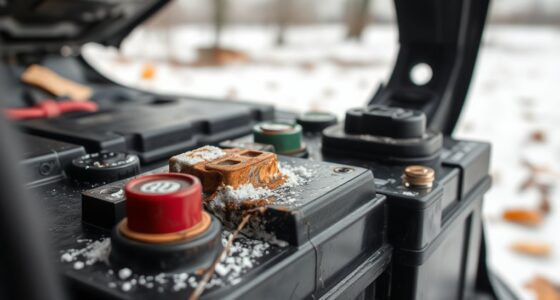To prepare an emergency kit for winter road trips, gather essentials like blankets, non-perishable food, bottled water, a flashlight with extra batteries, a basic first aid kit, and necessary medications. Pack tools such as a jumper cable, ice scraper, and tow rope, and include items for vehicle traction and safety. Keep your kit accessible in case of emergencies and make sure everything is well-stocked. Continue exploring to find tips on customizing your kit for winter conditions.
Key Takeaways
- Include blankets, non-perishable food, bottled water, and a flashlight with extra batteries for emergencies.
- Pack basic first aid supplies and necessary medications to handle minor injuries or health issues.
- Carry tools like jumper cables, an ice scraper, tow rope, and a multi-tool for vehicle repairs.
- Ensure the emergency kit is easily accessible and regularly checked for supplies and functionality.
- Consider adding extra clothing, hand warmers, and a portable phone charger to stay prepared for all conditions.

Winter weather can catch you off guard, so it’s essential to be prepared before hitting the road. One of the best ways to do this is by guaranteeing your vehicle is in top shape through proper vehicle maintenance. Before setting out on any winter trip, check your tires. Make sure they have sufficient tread and are properly inflated, as good traction is necessary in icy or snowy conditions. Replace worn tires or consider snow tires if you often travel in winter weather. Additionally, inspect your windshield wipers and replace any that are streaking or cracked. Keep your windshield washer fluid topped off with a winter-grade formula that won’t freeze. Check your battery’s health, since cold temperatures can weaken it, leaving you stranded with a dead battery. Fluids like antifreeze should be at appropriate levels, and hoses and belts should be inspected for wear. Performing these maintenance checks reduces the risk of mechanical failure when you need your vehicle most. Regularly inspecting your vehicle’s performance under winter conditions can help identify potential issues before they become serious problems.
Equally important is weather monitoring. Before leaving, consult reliable weather sources to understand the forecast along your route. Keep a close eye on any warnings for snowstorms, icy roads, or sudden drops in temperature. Weather conditions can change rapidly, so staying informed helps you decide whether to delay your trip or adjust your route. During your drive, periodically check updates on local traffic and weather alerts, especially if traveling through rural or mountainous areas where conditions can deteriorate quickly. If you notice worsening weather, consider pulling over in a safe location before conditions become dangerous. This proactive approach minimizes the risk of accidents caused by unexpected winter storms or black ice.
Combining diligent vehicle maintenance with vigilant weather monitoring equips you to handle winter road challenges confidently. Proper vehicle maintenance guarantees your car is ready to perform under harsh conditions, reducing the chance of breakdowns. Meanwhile, staying informed through weather monitoring helps you make smarter decisions, avoiding hazardous roads altogether when necessary. Both steps are essential in preparing your vehicle and yourself for winter travel. Remember, the goal is to stay safe and comfortable, no matter what winter throws your way. Pack your emergency kit with essentials like blankets, food, water, and a flashlight, but don’t forget that a well-maintained vehicle and current weather information are your first line of defense. When you combine these precautions, you’ll be better equipped to face winter’s surprises and arrive at your destination safely.
Frequently Asked Questions
How Often Should I Update My Winter Emergency Kit?
You should update your winter emergency kit at least once a year, ideally before your winter road trip planning begins. Regular vehicle maintenance helps identify any issues that could hinder your kit’s effectiveness. Check your supplies for expiration dates and replace items like food, water, and batteries as needed. Doing this guarantees your kit stays reliable, keeping you safe and prepared during unexpected winter conditions on the road.
What Are the Best Items for Long-Term Winter Emergencies?
Did you know that 25% of winter road trip emergencies involve long-term stranded situations? To stay prepared, pack essential survival gear like a multi-tool, flashlight, and first aid kit. Don’t forget sturdy winter clothing—thermal layers, gloves, and hats—to keep warm. Also, include non-perishable food, water, and a portable phone charger. These items guarantee you’re ready for extended periods of winter emergencies on the road.
How Do I Store My Emergency Kit for Maximum Safety?
You should store your emergency kit in a cool, dry spot in your vehicle, preferably in a container that insulates against extreme temperatures. Keep it away from direct sunlight and moisture to prevent damage. Regularly check your vehicle insulation for any wear, and update your emergency contact lists to ensure they’re current. This way, your kit remains safe, accessible, and ready when you need it most.
Are There Specific Items for Children or Pets in the Kit?
Yes, include child safety items like extra warm clothing, diapers, and snacks, ensuring they’re easily accessible. For pet preparedness, pack water, pet food, and a leash. Keep these items separate from general supplies for quick access during emergencies. Always check that your child safety gear fits correctly and that your pet’s needs are met, so everyone stays safe and comfortable during winter road trips.
What Should I Do if My Car Battery Dies in Winter?
If your car battery dies in winter, first stay calm and turn on your hazard lights. Try car battery troubleshooting by gently rocking the vehicle or checking connections. For winter car maintenance, make certain your battery is clean and securely mounted. If it still won’t start, call roadside assistance or use jumper cables from a nearby vehicle. Regular winter car maintenance, like battery checks, helps prevent this issue.
Conclusion
By assembling a well-stocked winter emergency kit, you’re not just prepared—you’re practically invincible against nature’s icy fury. With the right gear, you can navigate even the most treacherous roads as if you have a secret shield. Don’t underestimate the power of preparation; it’s your best defense against becoming a frozen statistic. So, pack smart, stay safe, and remember—your readiness could be the difference between a chilly inconvenience and a life-saving miracle.








